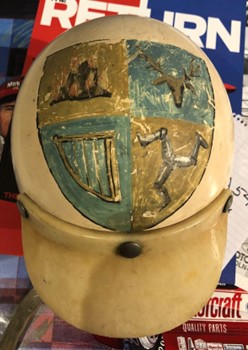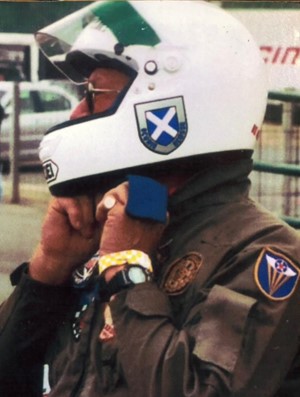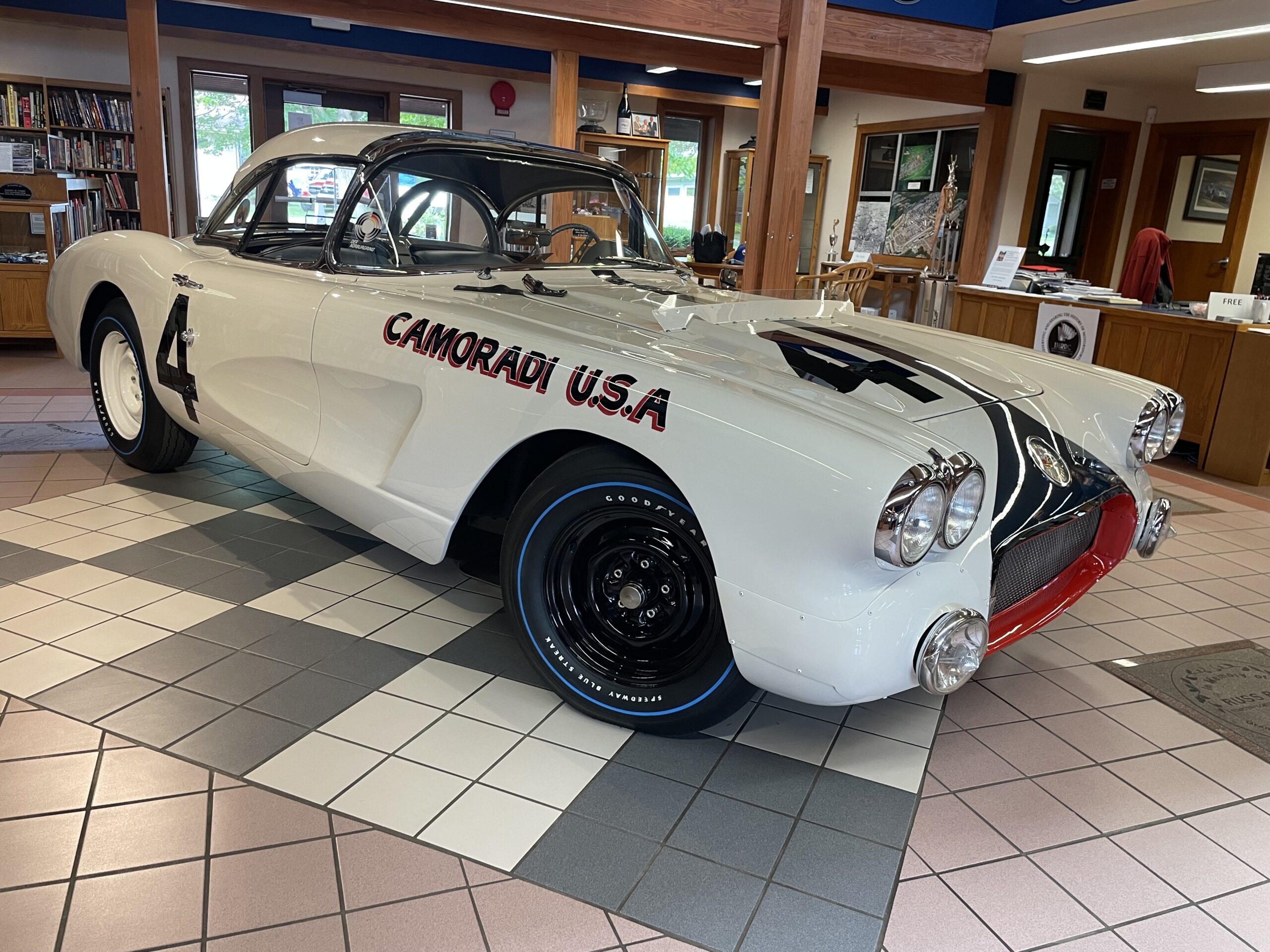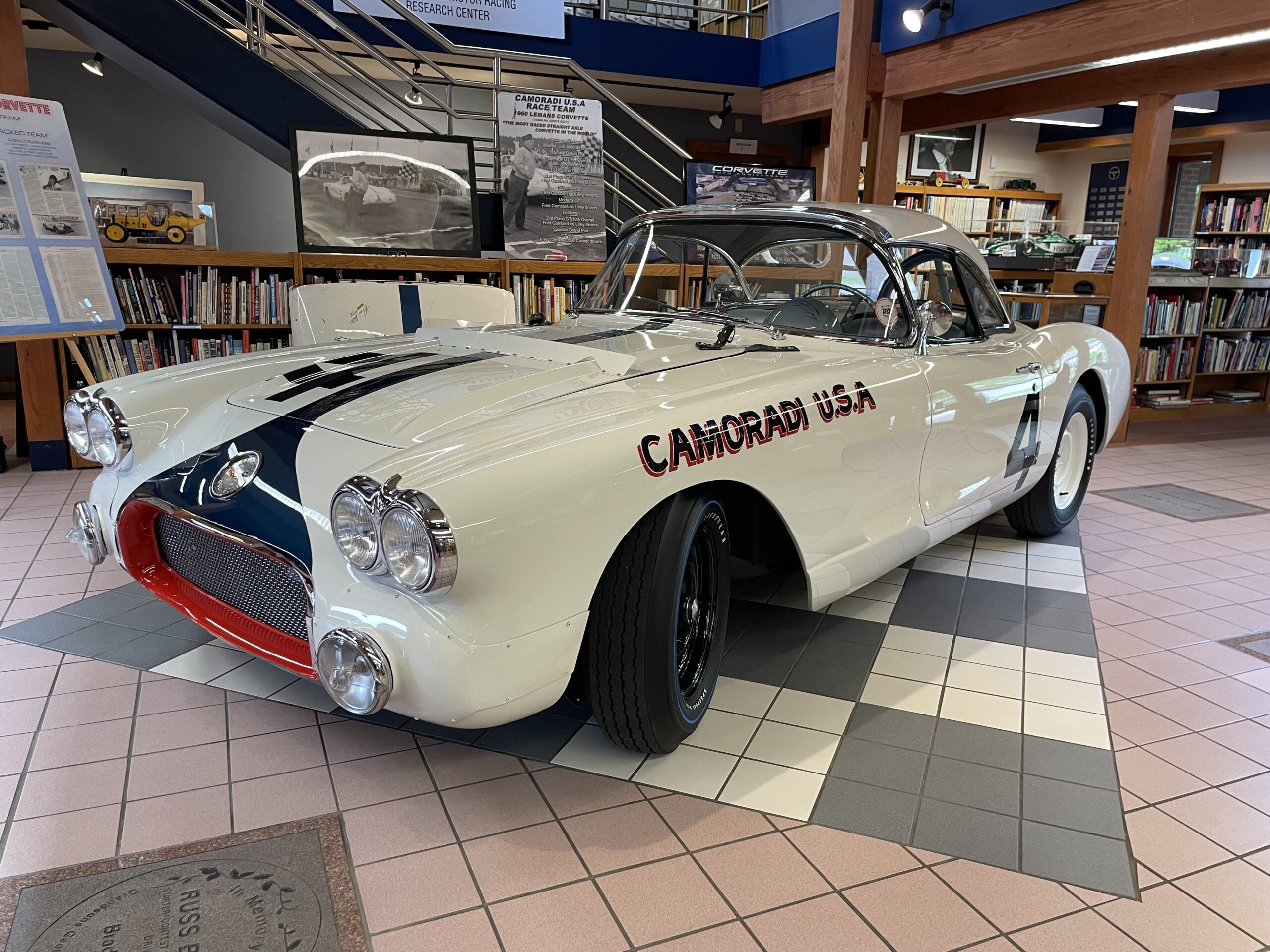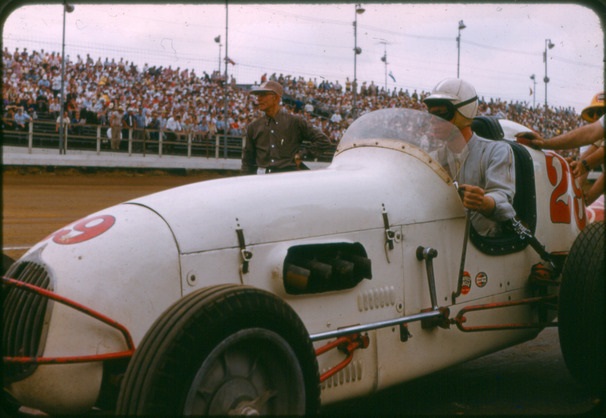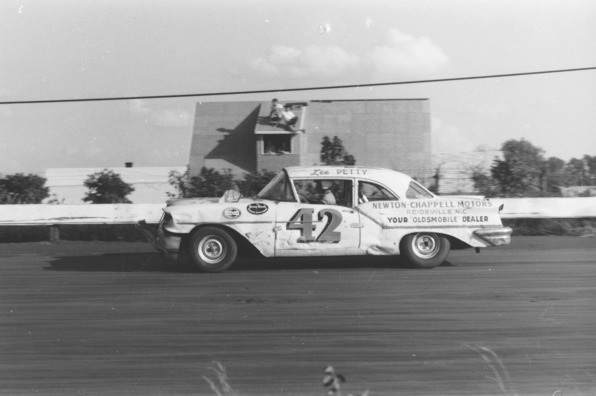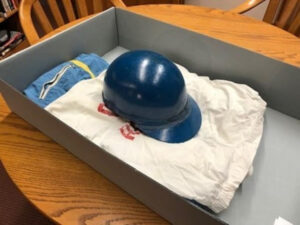The Research Center is honored to have this spectacular car on display and wants to thank the owner, Mark Malley, for the opportunity to share it with our guests.
The car is powered by a 1600cc Toyota 4AG engine built by Paul Hasselgren of California. The transaxle is a Reynard F3 box with a Hewland MK5 5-speed transmission. Ground effects technology is extensively used in the sidepod design and the undercarriage, similar to today’s technology. The top speed is approximately 150-160 MPH.
The car has run in multiple SCCA National and Regional events, as well as SVRA competitions at The Glen, Lime Rock, Road Atlanta, and Barber Motorsports Park.
Adrian Reynard built his first race car at age 23 while working for British Leyland. He became one of the most successful proprietor engineers in race car manufacturing in the world. Reynard Motorsports grew into one of the leading producers of race car chassis, and in the 1980s and ’90s, Reynard chassis dominated British Formula 3, International F3000, and Formula Atlantic. From the mid-1990s to the early 2000s, Reynard chassis were also dominant in Indy car racing, winning two Indianapolis 500s and numerous championships.
Racing helmets have an undeniable appeal for most race fans. Like a cars livery, their designs can be colorful or muted, complicated or simple. Who can forget Jackie Stewart’s helmet with its tartan “halo,” Senna’s unmistakable yellow, green, and blue helmet, or Emerson Fittipaldi’s swooping red on blue/black design. Above all, helmets can be expressions of a driver’s personality.
Racer Gordon “Gordy” MacKenzie (1926-2022) was born in Millbrook, NY, but you would never know it. His name is as Scottish as Scottish gets; he was famous for wearing a kilt to the track. MacKenzie enjoyed a long racing career that started in the early 1950s and lasted until the late ’60s. His retirement lasted over 20 years until he returned to racing in 1996, participating in vintage racing events at Lime Rock Park, driving a Lotus Europa. Over his career, he raced at numerous tracks, including Watkins Glen, Thompson, and Sebring. Still, MacKenzie’s “home” track was Lime Rock Park, where he drove in the inaugural race in 1957. The car he is most associated with is his C-Type Jaguar, which he drove with great success through much of his career.

MacKenzie takes the checkered flag on July 4, 1960 at Lime Rock Park. The flag is being held by his wife, Jillian: “That is me holding the flag, not Mac. It was rather uncomfortable, I was under the cockpit cover on the passenger side with just enough room for my head to come out between the edge of the cover and Mac’s head.” Photo from the MacKenzie Archives. 22A30
Among the many treasures in MacKenzie’s archive are two helmets he wore during his career. One dates from the 1950s-60s, it can be seen in the two photos above. The second is a more modern Shoei RF-4 helmet from his vintage car racing years. Just like his kilt, MacKenzie’s helmets tell us a great deal about him and how much he valued his heritage.
The first helmet, dating to the late 1950s, is white with a matching white visor from an unknown manufacturer. On top of the helmet is a painted Heraldic shield. The paint is worn and faded, evidence of use and age, but the symbols in its fields of blue and gold are clear. In the upper left field is the crest of the MacKenzie Clan, a burning mountain. In the upper right, a stag, perhaps a Red Deer or the Scottish Stag, a national symbol of Scotland. On the lower left, is a harp, the Irish national Symbol. On the lower right is the symbol of the Isle of Man, a triskelion composed of three armored legs with golden spurs. One wonders about MacKenzie’s association with Ireland and the Isle of Man (though the Isle of Man certainly has a long association with racing), but his message is clear.
The second helmet is a white Shoei RF-4. MacKenzie’s name is prominently displayed above the visor. The top is again painted, this time with the MacKenzie family crest, the burning mountain surrounded by a belt, along with the clan’s motto, “Luceo non Urbo”: “I Shine not Burn”. On opposing sides of the helmet, MacKenzie has added stickers with the emblems of Scottish racing team Ecurie Ecosse (”Scottish Stable”) and the emblem of the Road Racers Drivers Club. Interestingly, close inspection of the green tape on the visor reveals the word “Lotus” in raised letters under the tape. Again, his Scottish heritage is the defining theme of the helmet.
One of the most appealing things about both helmets is that the designs are clearly painted and the stickers applied to helmets MacKenzie purchased. They don’t have the polish of modern helmets worn by professional racers; they were handled, perhaps even painted, by the driver and others around him. They look and feel personal. You could literally do the same thing to your own helmet.
Throughout racing’s history, helmet design has been a popular form of expression for drivers and of great interest to fans. Just as in other sports fans sometimes choose their favorite teams based on uniform colors and designs, helmet designs are part of what attracts racing fans to different drivers. Helmets are highly sought after racing collectibles as they are among the most personal items associated with drivers. We are extremely fortunate to have MacKenzie’s helmets in our collection.
The Camoradi USA Racing’s 1960 Corvette was built for international competition under the auspices of Chevrolet General Manager Ed Cole and Corvette Chief Engineer Zora Duntov and went on to race successfully in Havana, Daytona, Sebring, Nürburgring, Sweden, and Le Mans. The only thing more amazing than this car’s creation and race record is its survival. On the way to Britain’s famed Goodwood circuit in August 1960 it was crashed hard and left for dead but miraculously, the shattered remains were preserved and discovered some thirty years later by Loren Lundberg, an unbelievably tenacious Corvette enthusiast from Glendale, Arizona. Learn how Loren found and rescued the car, and how he and current caretaker Dominick Testa went to great lengths to restore it and make sure its incredible story would not be forgotten.
Learn more about the Camoradi Corvette from famed Historian, Author and Photorgrapher: Richard Prince
The historic Camoradi Corvette will be on display at the IMRRC thru our June 22, Center Conversation: “The Greatest Corvette Story Ever Told”
Visitors to the IMRRC would be justified in thinking our collections are mostly made up of materials on drivers, cars and races. Why not? It’s largely true. Much of the racing literature is focused on racers, their cars, the results of specific events. But among our rich archives are several that focus on other aspects of racing. One recently-donated example is the Gordon Ensing Collection of materials on the West Michigan Grand Prix (collection number 22A21). This the second supplement to Gordon Ensing’s original collection, gifted to us in 2015 (15A54). Ensing’s first donation and supplement included posters from race events in the 1980’s-2000’s; framed prints of IMSA and CART cars and drivers; programs from CART, Formula 1, SCCA, IMSA, and other racing series (a boon to our extensive collection of racing programs!)
Programs from the 1998 and 1999 West Michigan Grand Prix. Both races ran on the 1.5 mile Scott Brayton Memorial Street Circuit in downtown Grand Rapids and featured Trans-Am Series races as their featured race. 22A21
The second supplement to Ensing’s collection consists of documents related to the planning and running of the West Michigan Grand Prix in Grand Rapids in 1998 and 1999. Among the materials are: West Michigan Grand Prix Association (WMGPA) corporate records dating from 1994 to 1999; notebooks titled “Race Operations”, “Operations Manual”, “On-site Marketing Manual”, “Sponsor Handbook”, “Event Operations Manual”, “Post-Event Analysis,” and “Construction” (2 vols.); publicity and media material in print and video formats; graphics such as race guides and spectator maps; and a large collection of relevant newspaper and magazine articles.
Gordon Ensing was uniquely positioned to collect these materials. As a Director of the West Michigan Grand Prix, he was there from the beginning the Association’s efforts to host the Grand Prix, to the successful inaugural running in 1998, through to the decision not to host a Grand Prix in 2000. His archive offers a unique behind-the-scenes perspective on the history of the Grand Prix. The bulk of the collection consists of various handbooks detailing racing operations. Particularly intriguing are the “Post-Event Analysis,” a retrospective evaluation of the 1999 Grand Prix and a notebook on “Construction” which includes correspondence, meeting minutes, and maps related to the engineering and construction of the course.

The 1999 West Michigan Grand Prix “On-Site Marketing Manual” and “WMGP Design & Operation Manual.” Two of several notebooks in the Archives concerning race operations and preparations. 22A21
Among the more intriguing items in the collection are items documenting efforts to promote the race. Included are several copies of a glossy colored booklet titled “Corporate Sponsorships: 1999 West Michigan Grand Prix,” a prospectus detail marketing opportunities for corporate sponsors of the race. This booklet was likely distributed to perspective sponsors.

“Corporate Sponsorships: 1999 West Michigan Grand Prix.” A booklet detailing opportunities for potential Corporate Sponsors. 22A21
More unique is a Certificate of Appreciation awarded to the West Michigan Grand Prix in recognition of their participation and support of the West Michigan Science Festival, which ran from April 18-25, 1998. An evaluation of the Science Fair is also included. Clearly the organizers of both the Science Fair and the Grand Prix were keenly interested in the impact of their events.

A Certificate of Appreciation awarded to the West Michigan Grand Prix in recognition of their participation in and support of the West Michigan Science Festival. 22A21
Still more unique, and a favorite item in the Archive, is an unused half-gallon container for Fast Trax Sundae Country Fresh Ice Cream. The ice cream appears to be another marketing campaign for the West Michigan Grand Prix as a note on the box indicates: “Visit Country Fresh online through our link @ www.westmichigangrandprix.com.”

An unused half-gallon container for Fast Trax Sundae Country Fresh ice cream: mini brownie fudge tires in vanilla ice cream streaked with dark chocolate. 22A21
The item with the most emotional resonance is surely the draft of the press release announcing the WMGPA Board of Directors’ decision not to host a Grand Prix in 1999. Dated November 11, 1999, the release discusses the Board’s efforts to find a title sponsor, efforts that ultimately failed despite their finding “a good deal of general support for the race through discussions we had with many different companies.”

Draft press release dated November 11, 1999 announcing the WMGPA’s plans to discontinue the Grand Prix in 2000. 22A21
As we build the International Motor Racing Research Center’s Archives, we strive to document all aspects of racing and the business of racing is of particular interest to the Center. We are grateful to Gordon Ensing for collecting these materials and entrusting them to the IMRRC for preservation and use by racing researchers.
During the last several months, the IMRRC has undertaken processing of the valuable and unique Joseph Braig Photographic Collection, which was donated to us for archival storage without limitations on usage by the Braig family. We prepared a presentation of the material for viewing by Mr. Braig’s widow and extended family when they made a formal visit to the IMRRC in April. This collection is expected to be a major asset to the IMRRC’s photographic resources and will be used in exhibits, presentations, and made available for reproduction, with attribution, under the terms of our fee structure.
Joe Braig was a skilled photographer who was employed by National Speed Sport News, a publication that served as a virtual bible for American motorsports. His rare pictorial documentation of a unique period in motorsport history is the only collection of this scope and quantity known to exist. Joe Blinebury, Jr., noted motorsports historian, characterized this collection as a “collector’s treasure” and of “museum quality.” Chris Economaki, editor and publisher of National Speed Sport News, a major figure in American motorsports who became a close friend of Mr. Braig, said, “Joe’s photos are among the very best we ever published.”
In addition to fascinating scrapbooks maintained by Mr. Braig, the collection consists primarily of many hundreds of individual prints and digital images, the latter often accompanied by contact sheets, of primarily dirt and asphalt oval track motor racing subjects from Langhorne, Williams Grove, Reading Fairgrounds, Trenton, Indianapolis, and other classic oval tracks from the 1950s to the 1980s.
When Howard Purdy and Bob Hodgson chalked out the frame for the Purdy Deuce on the floor of his parent’s home in 1964, little did they know that the car would be one of the dominant cars to compete at the famed Oswego Speedway from the mid 1960’s thru 1974…as well as ultimately become one of the most iconic supermodifieds in the history of the sport.
The car debuted late in the 1964 season but was plagued by “new car” issues. The 1965 season however was a revelation as driver, Ron Lux, won 5 features in a row and 12 of the 16 races held, easily winning the track title. In several of those wins, Lux used an alias as he was afraid of losing his USAC sprint car license. That year, the car also made its first – and only – race ever on dirt, racing in the National Open at the Williams Grove Speedway. Lux was running 5 th when he hit a rut and spun out. Sadly, Lux was fatally injured in a sprint car crash in July 1966 in Tulsa.
The winter before he died, Lux had suggested a young, New England driver, Bentley Warren as a candidate for the ride. Purdy wanted a more experienced driver, but after trying several veterans with no success, he put Warren in the car. Warren drove the car from 1966 – 1969, winning 7 features in that span, including the 1969 International Classic, the biggest race of the year. Canadian Warren Coniam was behind the wheel in ’70 and ’71 winning 2 features and the final driver was the late Jimmy Winks, who won 5 features including the car’s final race in 1974.
Small block and big block injected Chevy motors have powered the car over the years. The current restoration carries a 1960’s small block Chevy. In its time at Oswego The Deuce racked up 25 wins – 11 seconds – 5 thirds with 1 track championship and 1 win in the International Classic.
The car was competitive throughout the eras of upright supers, the sleeker, Indy roadster style bodies, and even when rear engine supers were running. The historic Purdy Deuce will be on display at the IMRRC thru our May 11 Center Conversation “Oswego Supers: A Legacy of Speed at The Steel Palace”
Check out this recently discovered footage from the early 1970s from the Oswego, NY area, comes a look behind the scenes with the legendary super-modified race car “The Purdy Deuce” – learn more at our Center Conversation in May. The video below is courtesy of, and with special thanks to, it’s creator Robert Syrell.
Learn from Kip about the importance of this legendary race on this TL:DR “pit stop” episode provided by The Motoring Podcast Network.
Transcript: Our current display car is one of the more iconic cars in the history of Oswego supermodified racing. It’s a car called The Purdy Deuce. The Purdy Deuce was built by a gentleman by the name of Howard Purdy. And he and his partner, Bob Hoxton, laid out the chassis on his parents floor in 1964. This was going to be the 56 car that Mr. Purdy had built in his career. And little did either of them realize that this car would subsequently go on to become one of the dominant cars in the mid [00:01:00] 60s through the early 70s at Oswego.
It’s what they call an upright, and you can see that by looking at the pictures. The driver basically sits upright behind a big steering wheel. The engine and the drivetrain are offset 7 inches. The car is powered by a 1960 small block Chevy engine. Now, this car competed at Oswego from 1964 to 1974.
It won 25 features, including the 1969 International Classic 200, which is the biggest race of the whole season at Oswego Speedway. That race was won by Bentley Warren. It won its last race in 1974, and then it disappeared to Howard Purdy’s bar. And it sat there, and it sat there, and it sat there. And for people like myself who are old enough to remember having seen it race at Oswego, the lore grew each passing year.
Are we ever going to see the car again? Is the car just going to rust away to nothing? What’s going to happen of it? For whatever reason, Mr. Purdy was never intent on having it restored. [00:02:00] But interestingly enough, Sadly, after Mr. Purdy died, his son, Chris, and only within the last couple of years, has there been kind of a groundswell from a lot of the people that actually worked on the car originally in the mid 60s to actually get the car out, restore it, and get it so people can see it.
So that project went on last year. Multiple people: Doug Holmes did the engine, a fellow by the name of Steve Miller did the body, Lee Osborne did the power coating. It all happened, and it was all done interestingly enough in time for last year’s International Classic in September, and the great Bentley Warren, who was driving the car when it won that 69 Classic, actually took it for some laps around the track.
Now, the current engine, Is dynoed at something like 580 horsepower. So Bentley was running 18 second laps at Oswego, and he could have run faster, got a brand new motor in it, but it’s got 50 year old shocks. So he couldn’t really run quite as fast as he’d like to. Bentley is in his early 80s. Bentley is probably one of the coolest guys walking the [00:03:00] face of the earth. He made the Indy 500 twice. He was a multiple time Oswego Speedway champion, multiple time international classic winner. One of the interesting things about this car is that this car ran through a number of different styling changes and types of cars that were running at the Speedway. You went to a more traditional offset car, farther offset car.
There was even rear engine cars at that time that were competing against it. It’s Zenith year was in 1965 where it won 11 out of 12 features driven by a guy named Ron Lux. Mr. Lux was sadly killed in a sprint car accident. Several different drivers hopped in the seat after that. Then Bentley got in the car.
Bentley drove the car for two or three years, did very well with it. A fellow by the name of Warren Conium from Canada drove the car for a couple of years, did okay with it. The last driver to actually win in it was the late Jimmy Winks, and Jimmy won multiple features during the two years he raced in it.
For those of us that have been fans of Oswego Speedway, or simply those of us who are simply fans of iconic and game changing [00:04:00] race cars, the Purdy Deuce is one of those cars that’s really high up on that list. I’m blessed with the fact that I never thought I’d see it again, much less be fortunate enough to actually have it here on the, on the center display floor.
And it’s going to be one of the centerpieces of our May 11 conversation. Oswego Super is a legacy of speed at the Steel Palace. Oswego is aptly known as the Steel Palace because the walls that surround the entire track, which is a five eighth of a mile oval, are steel. They are hard and they are unforgiving. So we are going to be doing a center conversation on May 11th, dealing with kind of the evolution, the history of super modified racing at the track, as well as fortunate enough to have the deuce here on the floor, and we’ll be recognizing the various people that were instrumental in the restoration of the car.
We’re going to have Bentley Warren here. We’re going to have Warren Conium here, and we’re going to have both Eddie Bellinger. Who won a fantastic 1983 international classic when both Bentley Warren and Warren Conium ran out of fuel on the last lap and we’ll have Eddie’s son, [00:05:00] Brandon, who is a current competitor at Oswego. So we’re hoping to tie together the generational aspect of racing at the Speedway. We’ll tie together the evolution of the car itself. And again, we’ll have truly one of the iconic cars in the history of the Speedway here on the floor, The Purdy Deuce.
The Center is constantly adding new materials to our Library and Archives and making them available to researchers.
The following Archival collections have been inventoried and processed recently. The material is available for researchers to use:
The David Crowther Collection
A collection of racing programs, rules/regulations, club directories and rosters, results sheets and communications with competitors dating from 1961-1982. The rules and regulations are primarily from the Canadian Automobile Sport Club, Ontario Region and include General Competition Rules, Solo Events, Rally and Ice Racing Regulations. Most of the race programs and race materials are from the Trophy Races at Harewood Acres, 1968-1970. Crowther competed in several of these Trophy Races and continued racing into the early 1980s.
The Robert Strebler Collection of Race Programs
A collection of race programs dating from 1971-2015. Venues covered include Belle Isle, Detroit; Michigan International Speedway; Road America; and the Wisconsin State Fair Park Speedway. Races at the Wisconsin State Fair Speedway are particularly well covered, with several programs dating from the early 1970s from the Tony Bettenhausen 200 Mile National Championship Race and the Rex Mays Classic 150 Mile Championship. This collection was a valuable addition to our race program collection.
The IMRRC’s archived collections represent over twenty-five years of generous donations. Collectively, they document the rich history of racing. Frequently, the contents of a donation are not known until the material arrives. Descriptions of donations may be detailed, but sometimes, as with the description above, there is a lack of specificity. This is why our first priority when a donation arrives is to inventory items prior to archival housing for long-term storage. For us, this can be the most exciting step in processing a collection, uncovering treasures along the way.
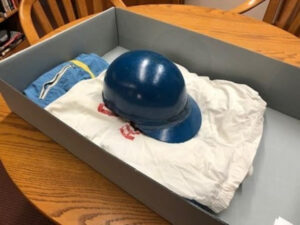
The Yochum collection prior to processing. The helmet is a Cromwell helmet, made in England. Yochum’s name is written on the outer rear of the helmet.
The Don Yochum Collection, a compendium of personal racing memorabilia from Don’s racing career in the 50s and 60s, is a perfect example of this process of discovery. Looking at the unprocessed material in its banker box, there were some obvious exciting items: A brilliant blue vintage helmet and a racing suit sat on top. It wasn’t until we began the inventory that we began uncovering the story of Don, Doug, and Del Yochum, or the “3Ds” as they were known. A trio of racing brothers who frequented NY race tracks in the 1950s.
Among the items underneath the clothing, were the pages of an old adhesive photo album filled with images of Don, Doug and Del’s racing days. As part of the processing, the photos will be removed from the album and placed in protective housing. These items are also candidates to be digitized and made available for researchers online.
In addition to the photographs, the collection includes magazines and newspaper clippings that document Don and his brothers’ careers.
Personal collections like the Don Yochum Collection are particularly valuable to the Center’s mission. Documenting the racing experience of the Yochum Brothers tells us not only about the family’s racing history, but also about racing in New York in the 50s and 60s, and – more generally – the racing careers of the many other racers mentioned in the sources. The IMRRC is honored to be entrusted with the preservation of these important motor racing artifacts.
An American sports car designed and built by California hot rodders, the Scarab holds a unique place in American road racing history. Funded by Lance Reventlow, heir to the Woolworth fortune, and built by Troutman and Barnes, the Scarab is powered by a small block Chevy from Traco Engineering. The car’s mission was to compete and win against the best European sports cars of the era.
Only three front-engine Scarabs were built in 1958, and they were immediately competitive, winning the SCCA National Championship in 1958. Driven by such notable drivers as Augie Pabst, Chuck Daigh, Reventlow himself, and the legendary Carroll Shelby, the Scarab competed – and won – at road courses around the country from the late 1950s to the mid-1960s.
Our MK 1 “Recreation” was originally owned by a noted collector, Larry Wilson of Jupiter, FL. We want to thank the current owner, John Petris of Tyrone, NY, for the opportunity to have this spectacular example of sports car racing history on display here at the Research Center.
New on the grid! The 1973 BMW 2002 currently owned by Bennie Bish from Whitney Point, NY. It has raced in the SCCA E Production class. Bennie purchased the car from Marc Feinstein in Boston. Stop in any time to take a look! We’re open 9-5 during the week, with special hours this Saturday, May 20th, 10-4 for our Center Conversation.








